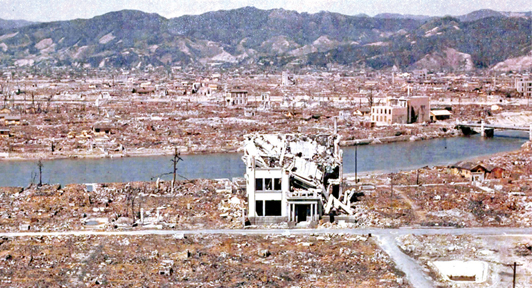Reflecting on WWII
 The Second World War is the most horrendous human conflict mankind has ever
experienced. Today, the world is reflecting on this massive human tragedy that
left at least 60 million people dead. Millions more were injured. The Second World War is the most horrendous human conflict mankind has ever
experienced. Today, the world is reflecting on this massive human tragedy that
left at least 60 million people dead. Millions more were injured.
The UN General Assembly has declared 8–9 May as a time of remembrance and
reconciliation and, while recognizing that Member States may have individual
days of victory, liberation and commemoration, invited all Member States,
organisations of the United Nations System, non-governmental organisations and
individuals to observe annually either one or both of these days in an
appropriate manner to pay tribute to all victims of the Second World War.
Assembly
The Assembly has stressed that this historic event established the conditions
for the creation of the United Nations, designed to save succeeding generations
from the scourge of war, and called upon the Member States of the United Nations
to unite their efforts in dealing with new challenges and threats, with the
United Nations playing a central role, and to make every effort to settle all
disputes by peaceful means in conformity with the Charter of the United Nations.
Just two locations need to be mentioned to stress the sheer scale of the
catastrophe that Second World War was. Auschwitz and Hiroshima. The very name
Auschwitz still sends a shiver down the collective spine of the world, 71 years
after Soviet soldiers liberated the Nazi concentration camp on January 27, 1945.
It is easily the darkest chapter in human history - up to 1.1 million people
were “exterminated” at this camp in Poland alone, during WWII. The Soviets thus
ended the largest mass murder in a single location in human history. Even
Treblinka, the next biggest Nazi camp in Poland, could not match these figures.
It was a Holocaust in every sense of the word.
Memories
A few elderly survivors still have bitter memories of the “Final Solution” which
was another term for the mass extermination of Jews and other people. In January
1942, the first chamber using lethal Zyklon B gas was built on the camp. This
building was judged inadequate for killing on the scale the Nazis wanted, and
four further chambers were built. These were used for systematic genocide right
up until November 1944, two months before the camp was liberated.
|

Hirashima in 1946 |
Precise numbers are still being debated, but the German SS is believed to have
systematically killed at least 960,000 of the 1.1-1.3 million Jews deported to
the camp. Other victims included approximately 74,000 Poles, 21,000 Roma, 15,000
Soviet prisoners of war and at least 10,000 from other nationalities. More
people died at Auschwitz than at any other Nazi concentration camp and probably
than at any death camp in history.
Evidence
The Soviet troops found grisly evidence of the horror. About 7,000 starving,
emaciated prisoners were found alive in the camp. Polish authorities have
preserved much of the site, a including a few railway carriages that transported
the prisoners to their deaths. There is a debate on whether the site should be
demolished to efface those abominable memories, but on the other hand, future
generations should also know about the horrors that were perpetrated here in the
name of achieving racial purity. It is thus worth keeping the site as it is.
Seventy one years after the liberation of the camps, the victims are still
seeking prosecution for around 30 Nazi officials who are believed to have worked
at these death sites.
Business
August 6, 1945. The time was 8.15 a.m. The people of Hiroshima were going about
their daily business, quite oblivious to their impending fate. The Second World
War was still on and they heard an aircraft passing by. Just 645 metres above
their city, a huge fireball erupted, evaporating everything - and everyone - in
its devastating path. The city became a heap of ruins in a split second, devoid
of life. Although the bomb was nicknamed Little Boy, it caused immeasurable
damage to the city and traumatized those who were lucky enough to escape death
from the immense heat (4,000 Celsius) and radiation wave. Nearly 166,000 people
were not so lucky.
Walking along the gardens and paths of the beautiful city of Hiroshima, one
almost tends to forget the unspeakable horror faced by the peace-loving denizens
of Hiroshima on that fateful day. Today, 71 years after the Enola Gay aircraft
dropped its deadly cargo – the world’s first nuclear bomb used on a ‘living’
city – the city of Hiroshima has become a fierce defender of peace on the
planet.
Dome
Also known as the Atomic Bomb Dome, the Peace Memorial is the only building that
survived in the hypocenter area of the bomb. In fact, the bomb exploded almost
right above the dome, having missed the original target, the nearby Aioi Bridge
over the Motoyasugawa River by a few hundred feet. Designated a World Heritage
Site in 1996, the ghostly shell of the former Hiroshima Prefectural Industrial
Promotion Hall now serves as a symbol of the horrors of nuclear war.
Now a part of the Hiroshima Memorial Park, the Atomic Bomb Dome has almost
become an object of pilgrimage to thousands of people from all over the world.
You can only gaze at it from the outside perimeter fence, which is more than
enough to give you a clear idea of the vast scale of the destruction. At the
same time, when viewed with the nearby modern buildings, one can appreciate the
tenacity of the people of Hiroshima, who have moved on from that terrible event
and completely rebuilt their city in six decades.
Controversy
If the Atomic Dome gives an idea of the vast scale of the destruction of
physical buildings, the nearby Hiroshima Museum educates visitors on the human
suffering caused by the bombing including a wax rendition that depicts the scene
in Hiroshima exactly a minute after the bomb exploded. This particular exhibit
has become a subject of controversy because of the very graphic and lifelike
nature of the people depicted in it.
The museum also gives an overall picture of the events of August 6, 1945 through
the use of graphs and models and contains every single letter sent by the Mayor
of Hiroshima to the leaders of a number of countries whenever they conducted a
nuclear test. The mayors of Hiroshima and Nagasaki (the only other city that
suffered a similar fate, on August 9, 1945) are leading a consortium of mayors
opposed to war which has gained widespread recognition around the world.
Auschwitz and Hiroshima remind us of the futility of war and conflict, which we
in Sri Lanka have also experienced for nearly three decades. Today, when the
world somberly reflects on the horrors of World War II, all must be firmly
determined not to start another conflagration that could lead to World War III. |

